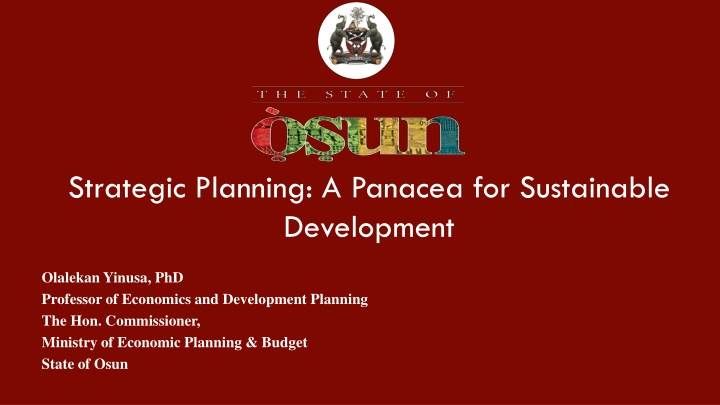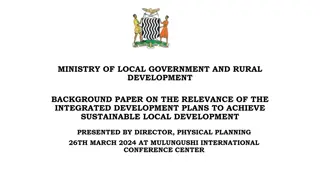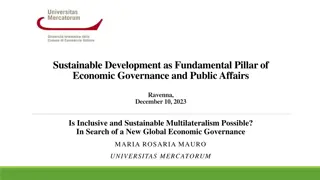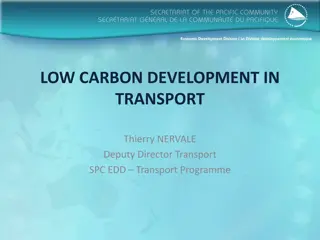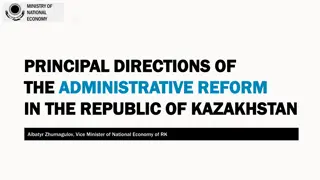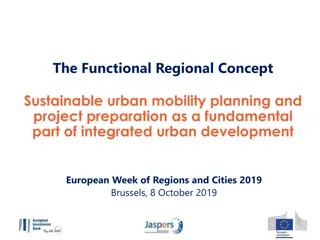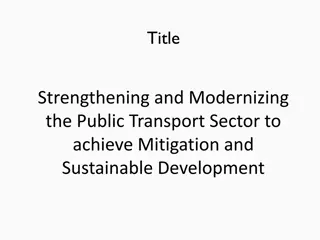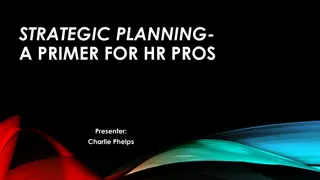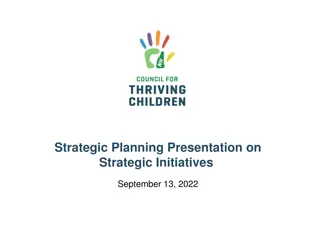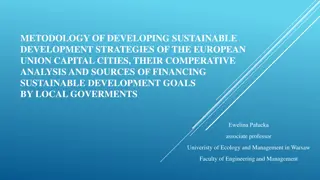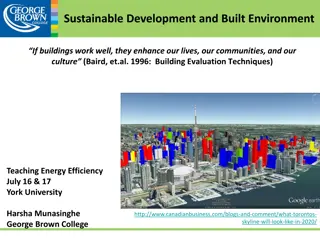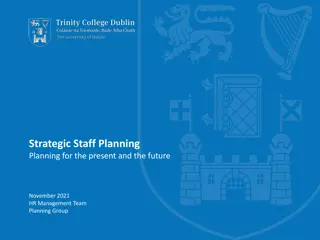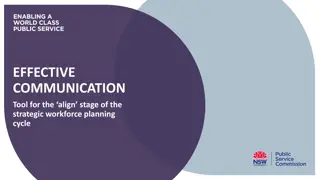Strategic Planning for Sustainable Development: A Comprehensive Overview
Planning and strategic planning play crucial roles in achieving sustainable development goals. This presentation delves into the concepts of planning, strategic planning, sustainable development, the SDGs, types of planning, steps in the strategic planning process, and the importance and challenges of strategic planning. It also highlights a case study of strategic planning in the State of Osun. The content emphasizes the necessity of effective planning to attain sustainable development objectives for the benefit of future generations.
Download Presentation

Please find below an Image/Link to download the presentation.
The content on the website is provided AS IS for your information and personal use only. It may not be sold, licensed, or shared on other websites without obtaining consent from the author.If you encounter any issues during the download, it is possible that the publisher has removed the file from their server.
You are allowed to download the files provided on this website for personal or commercial use, subject to the condition that they are used lawfully. All files are the property of their respective owners.
The content on the website is provided AS IS for your information and personal use only. It may not be sold, licensed, or shared on other websites without obtaining consent from the author.
E N D
Presentation Transcript
Strategic Planning: A Panacea for Sustainable Development Olalekan Yinusa, PhD Professor of Economics and Development Planning The Hon. Commissioner, Ministry of Economic Planning & Budget State of Osun
Outline of Presentation The Concept of Planning and Strategic Planning The Concept of Sustainable Development Sustainable Development Goals Types of Planning Steps in Strategic Planning Process A Strategic Planning Model Difference Between A Strategic Planning and other Planning Institutional Framework for Strategic Planning Qualities of A Good Planner The Importance of Strategic Planning Challenges of Strategic Planning Case of State of Osun (State Development Plan) Key Conclusions
The Concept of Planning & Strategic Planning Planning is defined as the process of deciding what objectives will be pursued within a future time frame. and what will be done in order to achieve those objectives. Strategic planning is a systematic process of envisioning a desired future, and translating this vision into broadly defined goals or objectives and a sequence of steps to achieve them. A strategic plan is a document used to communicate with the organization the organizations goals, the actions needed to achieve those goals and all of the other critical elements developed during the planning exercise.
The Concept of Sustainable Development Sustainable development is the idea that human societies must live and meet their needs without compromising the ability of future generations to meet their own needs. More specifically, sustainable development is a way of organizing society so that it can exist in the long term. Sustainable development is also the organizing principle for meeting human development goals, while simultaneously sustaining the ability of natural systems to provide the natural resources and ecosystem services on which the economy and society depend
Sustainable Development Goals (SDGs) There is no short-cut to achieving these 17 Sustainable Development Goals without proper, adequate and effective Planning
Types of Planning There are four major types of planning Strategic Planning: A strategic plan outlines mission, vision, and high-level goals for some years into the future (relatively long-term). It also takes into account how the goals would be measured, and the identified major projects to achieve the goals. Tactical Planning: Tactical Planning is the process of breaking down the strategic plan into distinctive, short or medium term plans Operational Planning: An operational plan (also known as a work plan) is a highly detailed outline of what a unit will focus on for the near future Contingency Planning: A contingency plan is a plan devised for an outcome other than in the usual (expected) plan
Sequence of Steps in Strategic Planning Process Strategic Planning involves logical processes which include the following; Identify Key Stakeholders Identify Strategic Factors for Key Stakeholders Access Performance on Strategic Factors Set Targets on Strategic Factors Develop Strategies to Achieve Targets Set Targets on Objectives Write Strategic Plan
Difference Between the Strategic Planning & other Planning Strategic Planning Other Planning Efficiency Bottom-up / Staff-generated Extends present 1- to 5-year horizon Effectiveness Top-down Creates future 5- to 20-year horizon Guides management behavior Little or no guidance for management behavior Internal customer focus Emphasizes the plan Reactive External customer focus Emphasizes the process Proactive
Institutional Frameworks for Strategic Planning Ministry of Economic Planning & Budget takes Lead Joint Planning Council Planning Teams (Sector Champions) The Role of Legislature Non-Government Actors Civil Society Organization (CSO), CBO, Representatives of Labour Organisations Religious Groups, Development Associations, Representatives of Organised Private Sector Development Partners Representatives of other Political Parties Extensive capacity building for all team members Legislation Vs. Non-Legislation of Plans
Qualities of A Good Planner Good Planner must possess: Quantitative and analytical skills Systems aptitude (ability to interact well with analytical software) Technical knowledge Global Perspectives Clear communication skills Ownership of every sectoral activities under his/her control
Qualities of A Good Planner Focus and keep track of activities Prioritization ability Sound judgment on issues Ability to follow-through each activity Proactive mindset/sense of urgency Positive attitude Skills to be a Team Player
The Importance of Strategic Planning Planning provides a sense of Direction: Planning involves predetermined action plan that states in advance what and how a task will be achieved Planning reduces Uncertainty: Planning not only sets objectives but also anticipates any future changes Planning reduces Wastefulness: The detailed plans keep in mind the needs of all the MDAs. This ensures that all the sectors are on the same page about the plan and that all their activities are coordinated.
The Importance of Strategic Planning Planning invokes Innovation: Planning encourages the leaders to broaden their horizons and forces them to think differently Makes Decision-Making Easier: planning involves setting goals, developing action plans and making predictions for future events. Decision is thus made with ease Establishes Standards: Oncethe planning is done, the leaders/managers now have set goals and standards. This provides the standards against which actual performances could be measured
Challenges of Strategic Planning It is a complex process It is time consuming It is difficult to implement It requires skillful Planning Planning cannot foresee everything, and thus, there may be obstacles to effective planning It may leads to rigidity. It may not work in a dynamic environment.
CASE OF STATE OF OSUN STATE DEVELOPMENT PLAN (SDP)
CASE OF STATE OF OSUN STATE DEVELOPMENT PLAN (SDP) Envisioning workshop Political Leadership is key! MTSS Training workshop MTEF Training workshop MTSS consolidation workshop SDP and MTSS Validations Meetings Comprehensive Media Plan
OUTCOMES OF PUBLIC FINANCIAL MANAGEMENT (PFM) REFORMS IN OSUN STATE It enhances budget reliability It reduces budget lobbying It guarantee effective monitoring and evaluation of development programs and projects It guarantee transparency and accountability It ensures inclusiveness and participatory governance
Key Conclusions The journey of a successful strategic planning process requires the following; Strong Political Will and Commitment Very focused Leadership in the Ministry of Economic Planning and Budget for Coordination of Strategic Planning Process Positive mental and attitudinal posture of planning teams The process must be inclusive for sustainability Communication must be continuous and ceaseless Adequate financial and other resources must be made available
THANK YOU Olalekan Yinusa, PhD Professor of Economics & The Honourable Commissioner, Ministry of Economic Planning & Budget State of Osun Email: hc.planning@osun.gov.ng
